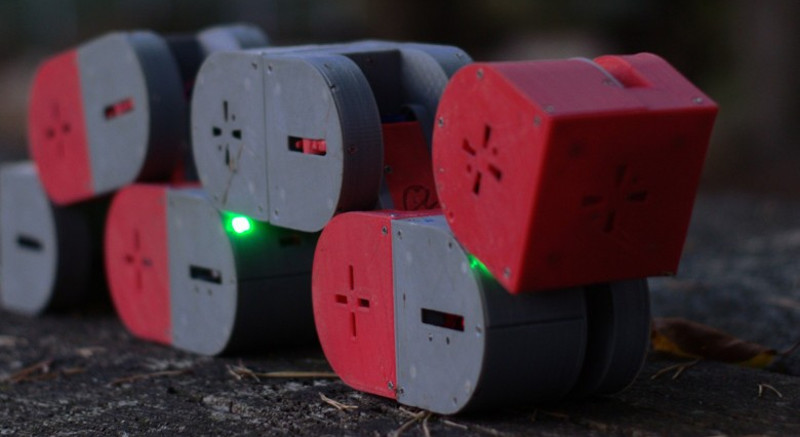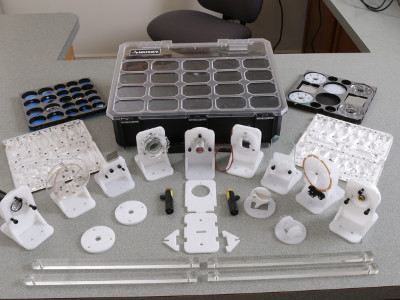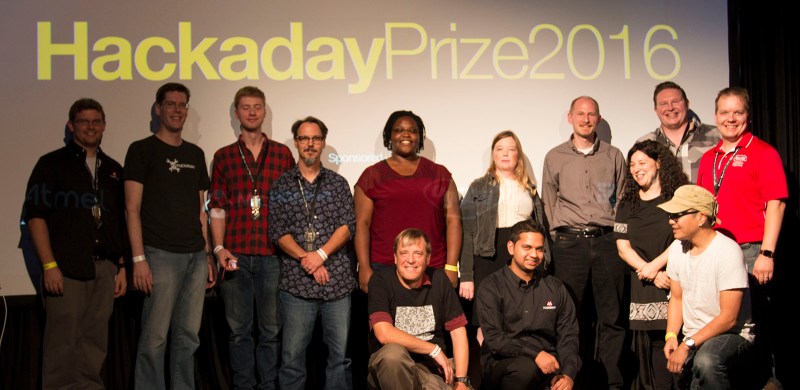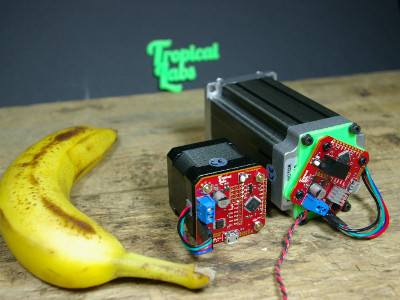Dtto, a modular robot designed with search and rescue in mind, has just been named the winner of the 2016 Hackaday Prize. In addition to the prestige of the award, Dtto will receive the grand prize of $150,000 and a residency at the Supplyframe Design Lab in Pasadena, CA.
This year’s Hackaday Prize saw over 1,000 entires during five challenge rounds which asked people to Build Something that Matters. Let’s take a look at the projects that won the top five prizes. They exemplify the five challenge themes: Assistive Technologies, Automation, Citizen Scientist, Anything Goes, and Design Your Concept. 
Dtto — Explorer Modular Robot
Grand Prize Winner ($150,000 and a residency at the Supplyframe Design Lab): Dtto is modular robot built with 3D printed parts, servo motors, magnets, and readily available electronics. Each module consists of two boxes, rounded on one side, connected by a bar. The modules can join with each other in many different orientations using the attraction of the magnets. Sections can separate themselves using servo motors.
Dtto is groundbreaking in its ability to make modular robots experimentation available to roboticists and hobbiests everywhere by sidestepping what has traditionally been a high-cost undertaking. While it’s easy to dismiss this concept, the multitude of different mechanisms built from modules during testing drives home the power of the system.

Affordable Reflectance Transformation Imaging Dome

Laser Cut Optics Bench
Third Place ($10,000): An optics bench is a series of jigs used to hold and precisely align elements for optical experiments. Traditionally this meant highly specialized equipment starting in the tens-of-thousands of dollars. But schools, hackerspaces, and individuals don’t need top-of-the-line equipment to begin learning about optics. The project has designed holders for salvaged optics and the ancillary materials to conduct experiments, and even includes a standardized carrying case design.






















Congratulations, truly amazing projects and build logs to be emulated!
Mechaduino needs to be turned into an actual product that you can purchase. Cheap steppers turned into closed loop control is really advantageous, especially if the price is low enough.
Ummm, it ….is?
http://tropical-labs.com/index.php/shop
This is also the project i was most excited about. Yknow, because I personally will actually use it and because I’m selfish.
I’m very excited to have a go at shoving a few of these into a reprap. Aside from obvious increases in positioning precision, with a torque limit on the filament extruder, you could detect blocked or obstructed nozzles, and prevent the majority of disappointing bird nests.
I can only confirm what Adjustinthings said.
I bought 2 of them regularly from the website and I got both of them unharm via mail from china.
Congratulations. These guys could not win without hard work, lost nights, tons of coffee, disappointments and successes.
Now I’ve got some questions for the organizers, judges and sponsors:
1. How do these projects make big changes in peoples’ lives?
2. Excepting the tilt sensor which is BRILLIANT, how do these expand the frontier of knowledge and engineering?
3. What solutions are provided to address technology issues facing humanity today?
Because today we are facing environmental pollution at high scale, caused by people who refuse to pull their heads from their butts and do something that matter – try to change this. We are facing a sky-high number of children with autism, cancers, congenital malformations, dwarfism, bone growth deficiency, retard and all sort of syndromes we never saw happening so often 30 years ago.
Today we are also facing accidents in factories, airlines and landlines, most of them caused by malfunctioning parts not tested properly or not tested at all. People keep dying all over around us: in car accidents, crushed under heavy equipment, thrown from heights, crashed with airplanes and so on, and there’s no “emergency button” to be pushed in time in case some artificial intelligence-based system detects some vibrations that should not happen.
Our dear ones keep dying, and there are a few strong people that can bring big changes in people’s lives – how? – helping a few passionate guys/gals pushing the frontier of knowledge and engineering so they can come with viable solutions to address technology problems facing humanity today. They can, but they won’t do that. In George Westinghouse’s style, I will give you the answer: “If all the humanity will benefit from our investment, where will we put the meter?”
Message for the winner: be careful what you sign.
I think that may seem to be the case because of how its reported. Pretty sure people are living longer healthier lives these days…..
Oh, no i guess you’re right. More autism.
Pretty sure the increase in autism cases is due to diagnostic ability rather than there actually being more autistic people being born. We’re just better at noticing it than we were in the past.
Exactly right. We’re better at noticing a whole lot of things better these days, which is why our popular perceptions seem to be going more and more at odds with reality. There’s a lesson there for all of us.
I’m speculating that future versions of Dtto will search for earthquake victims.
The Reflectance Transformation Imaging Dome could very well be revolutionary for ‘backyard archaeological researchers’, and because it allows the almost unquantifiable to be seen without big $’s it is just awesome.
#1 They Don’t
#2 They Don’t
#3 None
could use some help here instead of complaining
https://hackaday.io/projects/hacker/28790
I’ve seen those projects. Most of them don’t seem to offer an answer to those three queries either.
1) Changes in peoples lives. Some projects show an obvious, immediate positive effect. Others, and I’d include all the finalists in this second category, make it easier for others to come up with something that has a huge positive effect. As a student, I see self assembling robots, closed loop control, high precision measurement, a new way of documenting objects and a way to learn about lasers all suddenly withing reach, where before I would have put those things aside as inaccessible due to the large amount of funds or time required to get things working.
2) See 1 – many more eyes looking at problems because they can now afford the tools, maybe someone will discover a new species when they notice a difference only visible in an image from that RTI dome… maybe a mechaduino will drive the motion of a desktop gene synthesizer… my point is, these are enabling technologies
3) None of the finalists magically fixes a major problem like global warming, pollution or disease. I guess if we want that, we should get to work so we’re ready for next year :)
The environmental pollution problem could be solved by reducing our population.
We lack natural predation to keep the population healthy, reintroduce Smilodon :-D
OK… Guys, I’m not sure if this “change the world” is a good idea. I’m afraid that some good hacks and projects are disqualified by this, because their authors don’t want to enter something irrelevant and when I look at the winners, well it seems like the best approach is to just enter the competition and completely ignore what it’s about.
I agree the “change the world” could be deterring people.
Maybe I could have submitted my hack, but I’m afraid it’s too stupidly simple to compete in a ‘change the world’ comp against the likes of robots and such – a mercury tilt switch wired to the AC on/off switch in my old vehicle. When going up steep hills, it automatically turns the AC off until up and back on the level, when it comes back on again. Reduces my engine labouring and reduces fuel usage, saves me having to flick the button off and on manually. Has another switch across it to disable the ‘automatic’ off/on.
Disappointed that HAD awarded top prize to a stolen 12 year old project. Simply put “inspired by” and it’s a new idea that requires the judges to neither research into the originality nor verification that they have the rights to use the idea. (Note: I will happily retract this comment if Team DTTO procured the rights to duplicate this project.) https://unit.aist.go.jp/is/frrg/dsysd/mtran3/index.htm
I was already ready to reply with a thing about simultaneous invention, and two people with similar ideas being totally possible etc etc.
But no…your right that seems exactly the same :-/
The first prize needs to be re-evaluated if anyone is going to continue to take the Hackaday Prize seriously. I’ll give HaD 24 hours before I submit this irregularity to every technology rag on the internet (hyperbole, I know).
And I was reactionary with this response. So much for thinking before typing. The originator of the project does give credit to the original researchers as his inspiration.
The thing is, there’s almost nothing improved to an extent that could make me say that it really was inspired. This seems to be more pf a blatant rip off, rather than an inspired project.
Yeah, a rip off that is worth winning $150000, according to the Prize judges. The winners of previous editions of the prize were more original, but this??? I mean, according to the prize rules, the sixth criterion is the “wow” factor, the innovativeness of the entry. Where is the innovation of a project that is a copy of a robot from 1999???
Wow!!! I already thought that Dtto is not a proyect worth winning the $150000 prize (maybe it deserves the fifth prize), but after clicking that link my only thought is “WTF???” One thing is to take an inspiration to do something different, but Dtto is nothing but a plain copy of the M-TRAN robot! Where is the novelty/originality of this year’s winner? What a shame…
This is almost outrageous. WTF HaD Prize judges!
You should have done a little research before giving the first prize to a ripoff project.
Please reevaluate the first prize.
Have to agree with Invader. HAD judges fell for the classic “this robot could be used for saving lives” gimmick. Does anyone remember Greg Schroll and his spherical robot? Maybe this looks familiar: http://www.popularmechanics.com/technology/robots/a4662/4332921/
That was 2009. How many spherical robots have been used by military or first responders since then? Exactly zero.
I’m really tired of roboticists who don’t understand an application space telling people that they have a viable solution for something they don’t understand. If I’m going to trust my life to your robot (because that’s what happens if you are expecting a rescue robot to “save lives”), then it had better work 100% of the time for it’s intended use case. What happens to DTTO if one of the modules breaks? What if one of the batteries dies before the others? What’s the communications range when it’s inside a hole surrounded by rebar-reinforced concrete? Does it have the ability to provide its own illumination for cameras?
The truth is, DTTO is a toy for hobbyists and hackers. If it’s going to change lives or make a difference it will be in the education domain, not as a viable tactical robot.
This year’s winning projects seem a bit mediocre.
I was surprised that Dtto won. It is a nice project and someone put a lot of work into it. But it is in no way a new design or does it have any purpose whatsoever. It is a toy at best.
Mechaduino is at least something that makers will be able to incorporate into their design and build useful stuff out of it.
I think the winning project is awesome!
It may be derivative, but so are the servo and the imager. The current capabilities are limited, but opening this type of project up for people to build on has huge potential. Reprap was derivative too, and started with limited utility, but having an open collaborative effort enables people to improve and build.
Congratulations to the winners. May your project morph into an unstoppable scifi nightmare swarm of doom.